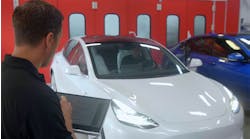In recent columns, I have presented ideas for you to consider as you develop your blueprinting standard operating procedure. Most recently, we discussed the need to have a standard for “pre-writing the repair plan” and the critical importance of this step. Please know that, unless you implement the pre-writing process, you will have unnecessary delays in your system and the burden of preventable costs that will cause a lot of frustration to everyone involved in the process.
So, let’s move forward to the next steps in your SOP. After the repair plan is pre-written, the blueprinter will need to start gathering all the pertinent information needed to complete the actual repairs. In my view, the best source of this information is going to be the OEMs and their online technical information services and workshop manuals. These OEM-sponsored, subscription-based websites go by many different proprietary names. For example, Audi has erWin, BMW has ISTA and AIR, GM has ACDelcoTDS, Honda has ServiceExpress, Toyota has TIS, etc.
How can you remember all the website addresses for the various OEM repair guides? Should you compile a list of the sites and save it somewhere on your computer? Quite a few years ago, I came across this quote from Albert Einstein. I believe the story is, a colleague asked him for his phone number, and Einstein reached for his telephone directory to look it up. “You don’t remember your own number?” the man asked, startled.
“No,” Einstein answered. “Why should I memorize something I can so easily get from a book?”
Mr. Einstein didn’t have the Internet to look things up, but his principle still applies. You don’t have to memorize or save the location of the websites because a couple of collision repair support organizations have compiled a directory of the OEM websites for you.
The OEM Collision Repair Roundtable and the National Automotive Service Task Force joined together to create the OEM1STOP tech info site. The web address is oemonestop.com. On the home page, you will see the brand logos for just about every OEM that sells vehicle in North America. When you click on one of the logo icons, you will be taken to links for the OEM collision repair sites. OEM1STOP also lists the position statements from many OEMs on topics such as wheel reconditioning, post-collision diagnostic scans, and inspections required after a collision. I highly encourage you to check out all the information available on the OEM1STOP website.
The other group that is highly regarded for compiling the OEM information websites is I-CAR. I-CAR has created the Repairability Technical Support Portal, which is found at rts.i-car.com. Access to the information in the RTS Portal is subscription based unless you are a Gold Class shop or a Platinum individual. Here you’ll find OEM technical articles and bulletins, position statements, and repair instructions. You’ll also find easy-to-use videos on how to effectively access collision repair information, directly from many of the vehicle makers. There is a ton of other useful information on the RTS site such as OEM procedures for disabling hybrid and electric vehicles and OEM calibration requirements.
I recommend you take a deep dive into the I-CAR RTS site and avail yourself to the training videos that teach you how to use the OEM repair sites. This will speed up the learning curve for you and the blueprinter and get you to the information you need as quickly as possible.
So now that you have two quick and easy ways to get to the OEM technical information websites, what is the information that needs to be collected once you are on the site? I believe that the blueprinter needs to research at least two specific areas. The first area of research can be termed “repairs and inspections required after a collision.” These required procedures are crucial to completing a repair to OEM standards. The blueprinter needs to locate these general procedures which are typically found in somewhat obscure areas of some OEM websites. That is perhaps one of the reasons why some of these procedures are not common knowledge in our industry. Let me share an example of what you will find on the General Motors website on the topic of repairs and inspections required after a collision:
GM Document ID: 2322743 Repairs and Inspections Required After a Collision
Accident With or Without Air Bag Deployment: Component Inspections
Warning: Proper operation of the supplemental inflatable restraint (SIR) sensing system requires that any repairs to the vehicle structure return the vehicle structure to the original production configuration. Not properly repairing the vehicle structure could cause non-deployment of the air bag(s) in a frontal collision or deployment of the air bag(s) for conditions less severe than intended.
After any collision, inspect the following components as indicated. If you detect any damage, replace the component. If you detect any damage to the mounting points or mounting hardware, repair the component or replace the hardware as needed.
- ∙ The steering column—Inspect the steering column for bending, twisting, buckling or any type of damage.
- ∙ The instrument panel knee bolsters and mounting points—Inspect the knee bolsters for bending, twisting, buckling, or any other type of damage.
- ∙ The instrument panel brackets, braces, etc.—Inspect for bending, twisting, buckling, or any other type of damage.
- ∙ The seat belts—Perform the seat belt operational and functional checks. Refer to Repairs and Inspections Required After a Collision.
- ∙ The instrument panel cross car beam—Inspect for bending, twisting, buckling, or any other type of damage.
- ∙ The instrument panel mounting points and brackets—Inspect for bending, twisting, buckling, or any other type of damage.
- ∙ The seats and seat mounting points—Inspect for bending, twisting, buckling, or any other type of damage.
- ∙ The roof and headliner mounting points.
- ∙ The brake pedal --Inspect the brake pedal for bending, twisting, buckling or any type of damage.
I want you to take a moment and re-read these required procedures and try to visualize how you and your team will go about completing the itemized tasks listed in the document. I also want you to think about how you would go about itemizing these inspections on your repair plan. How is the blueprinter going to communicate these requirements to insurance company appraisers? What is the plan for handling the potential consternation and pushback from third-party payers? Solutions to some of these challenges will be topics for future columns, so let’s get back to the blueprinting SOP.
To recap, “repairs and inspections required after a collision” is research job No. 1 for your blueprint SOP. In my next column, I’ll give you some more examples on this topic and then will give you some hints and shortcuts on the next area of research to be conducted by your blueprinter.




